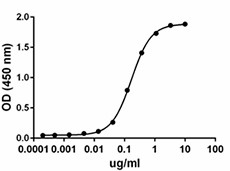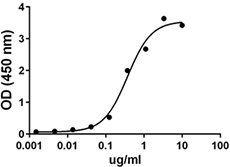- Regulatory Status
- RUO
- Other Names
- CD274, Programmed cell death 1 ligand 1 (PD-L1), B7 homolog 1 (B7h1)
- Ave. Rating
- Submit a Review
- Product Citations
- publications

-

Immobilized mouse PD-L1 binds mouse PD-1 in a dose dependent manner.
PD-L1 is a type I transmembrane protein of 290 amino acids, and it is a member of the B7 family. Mouse PD-L1 has 70% amino acid identity to its human orthologue. Binding of PD-L1 to its receptor PD-1 leads to the inhibition of T cell receptor–mediated lymphocyte proliferation and cytokine secretion. PD-L1 induces IL-10 production in T cells stimulated with low levels of anti-CD3. PD-L1/PD-1 interaction suppresses immune responses against autoantigens and tumors and plays an important role in the maintenance of peripheral immune tolerance. Disruption of the PD-L1 gene leads to up-regulated T cell responses and the generation of self-reactive T cells. Antibodies against PD-1 or PD-L1 leads to increased antitumor immunity. PDL1 has an important role in conferring fetomaternal tolerance in an allogeneic pregnancy model; antibodies against PD-L1 lead to a breakdown in maternal tolerance to the fetus. PD-L1 shares its receptor with PD-L2 (CD273, B7-DC). PD-L2 has a more limited expression than PD-L1, being expressed on activated macrophages and dendritic cells. PD-L1 is expressed in many tumors, and the interaction with its receptor activates signaling pathways that inhibit T-cell activity and therefore the antitumor immune response. Antibodies targeting PD1 or PD-L1 block the PD1 pathway and reactivate T cell activity.
Product DetailsProduct Details
- Source
- Mouse B7-H1, amino acids (Phe19-Thr238) (Accession# NM_021893), was expressed in 293E cells. Human IgG-Fc is in the carboxy-terminus.
- Molecular Mass
- The 458 amino acid recombinant protein has a predicted molecular mass of approximately 51.5kD. The DTT-reduced and non-reduced protein migrate at approximately 70 - 80kD and 140kD respectively by SDS-PAGE. The predicted N-terminal amino acid is Phe.
- Purity
- >95%, as determined by Coomassie stained SDS-PAGE.
- Formulation
- 0.22 µm filtered protein solution is in PBS, pH 7.2.
- Endotoxin Level
- Less than 0.1 EU per µg of protein as determined by the LAL method.
- Concentration
- 10 and 25 µg sizes are bottled at 200 µg/mL. 100 µg size and larger sizes are lot-specific and bottled at the concentration indicated on the vial. To obtain lot-specific concentration and expiration, please enter the lot number in our Certificate of Analysis online tool.
- Storage & Handling
- Unopened vial can be stored between 2°C and 8°C for up to 2 weeks, at -20°C for up to six months, or at -70°C or colder until the expiration date. For maximum results, quick spin vial prior to opening. The protein can be aliquoted and stored at -20°C or colder. Stock solutions can also be prepared at 50 - 100 µg/mL in appropriate sterile buffer, carrier protein such as 0.2 - 1% BSA or HSA can be added when preparing the stock solution. Aliquots can be stored between 2°C and 8°C for up to one week and stored at -20°C or colder for up to 3 months. Avoid repeated freeze/thaw cycles.
- Activity
- Immobilized mouse PD-L1 binds mouse PD-1 in a dose dependent manner. The ED50 = 0.1 - 0.5 µg/ml.
- Recommended Usage
-
Bioassay
- Application Notes
-
BioLegend carrier-free recombinant proteins provided in liquid format are shipped on blue-ice. Our comparison testing data indicates that when handled and stored as recommended, the liquid format has equal or better stability and shelf-life compared to commercially available lyophilized proteins after reconstitution. Our liquid proteins are verified in-house to maintain activity after shipping on blue ice and are backed by our 100% satisfaction guarantee. If you have any concerns, contact us at tech@biolegend.com.
- Product Citations
-
Antigen Details
- Structure
- Dimer.
- Distribution
- APC, monocytes, dendritic cells, expressed in nonlymphoid tissues, and stromal cell.
- Function
- Enhances CD28-independent T-helper cell function, suppresses immune responses against autoantigens, and participates in fetomaternal tolerance.
- Interaction
- Antigen-stimulated T and B cells, regulatory T cells, follicular T and B cells, dendritic cells, and monocytes.
- Ligand/Receptor
- PD-1 (CD279).
- Bioactivity
- Immobilized mouse PD-L1 binds to its receptor PD-1.
- Cell Type
- Embryonic Stem Cells
- Biology Area
- Immunology, Cancer Biomarkers, Costimulatory Molecules, Stem Cells
- Molecular Family
- Adhesion Molecules, CD Molecules, Immune Checkpoint Receptors, Soluble Receptors
- Antigen References
-
1. Dong H, et al. 1999. Nat. Med. 5:1365.
2. Freeman GJ, et al. 2000. J. Exp. Med. 192:1027.
3. Latchman Y, et al. 2001. Nat. Immunol. 2:261.
4. Latchman YE, et al. 2004. Proc. Natl. Acad. Sci. USA 101:10691.
5. Guleria I, et al. 2005. J. Exp. Med. 202:231.
6. Lin DY, et al. 2008. Proc. Natl. Acad. Sci. USA 105:3011.
7. Dai S, et al. 2014. Cell Immunol. 290:72.
8. Melero I, et al. 2015. Nat. Rev. Cancer 15:457. - Gene ID
- 60533 View all products for this Gene ID
- UniProt
- View information about B7-H1 on UniProt.org
Related FAQs
- Why choose BioLegend recombinant proteins?
-
• Each lot of product is quality-tested for bioactivity as indicated on the data sheet.
• Greater than 95% Purity or higher, tested on every lot of product.
• 100% Satisfaction Guarantee for quality performance, stability, and consistency.
• Ready-to-use liquid format saves time and reduces challenges associated with reconstitution.
• Bulk and customization available. Contact us.
• Learn more about our Recombinant Proteins. - How does the activity of your recombinant proteins compare to competitors?
-
We quality control each and every lot of recombinant protein. Not only do we check its bioactivity, but we also compare it against other commercially available recombinant proteins. We make sure each recombinant protein’s activity is at least as good as or better than the competition’s. In order to provide you with the best possible product, we ensure that our testing process is rigorous and thorough. If you’re curious and eager to make the switch to BioLegend recombinants, contact your sales representative today!
- What is the specific activity or ED50 of my recombinant protein?
-
The specific activity range of the protein is indicated on the product datasheets. Because the exact activity values on a per unit basis can largely fluctuate depending on a number of factors, including the nature of the assay, cell density, age of cells/passage number, culture media used, and end user technique, the specific activity is best defined as a range and we guarantee the specific activity of all our lots will be within the range indicated on the datasheet. Please note this only applies to recombinants labeled for use in bioassays. ELISA standard recombinant proteins are not recommended for bioassay usage as they are not tested for these applications.
- Have your recombinants been tested for stability?
-
Our testing shows that the recombinant proteins are able to withstand room temperature for a week without losing activity. In addition the recombinant proteins were also found to withstand four cycles of freeze and thaw without losing activity.
- Does specific activity of a recombinant protein vary between lots?
-
Specific activity will vary for each lot and for the type of experiment that is done to validate it, but all passed lots will have activity within the established ED50 range for the product and we guarantee that our products will have lot-to-lot consistency. Please conduct an experiment-specific validation to find the optimal ED50 for your system.
- How do you convert activity as an ED50 in ng/ml to a specific activity in Units/mg?
-
Use formula Specific activity (Units/mg) = 10^6/ ED50 (ng/mL)
 Login / Register
Login / Register 













Follow Us